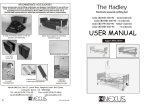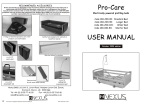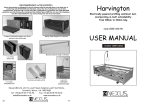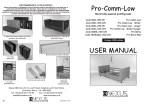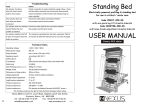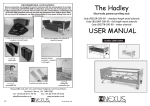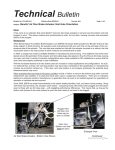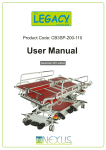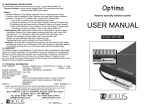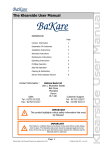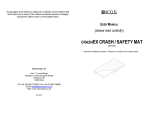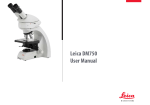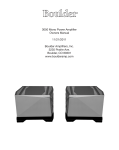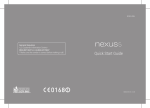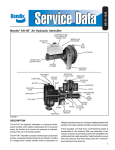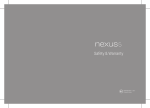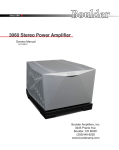Download Hampton User Manual 1009
Transcript
RECOMMENDED ACCESSORIES Nexus accessories are designed to work in harmony with the moving parts of our beds and, in conforming with EN1970-2000 bed Standard, reduce the risk of entrapment. Use of other manufacturers’ products with our beds may take a bed/mattress combination out of EN1970-2000 guidelines and may increase the entrapment risk. Neither Nexus DMS Ltd, nor any of its employees, can take responsibility for any issues arising from use of such products. Hampton Electrically powered profiling bed Code CB12TR-200-90 USER MANUAL A range of matched pressure care & nonpressure care mattresses Safety foam bumpers for siderails & head/foot boards October 2009 edition Matched siderail extenders DMS Ltd NE XUS crashEX safety mat safety mat lightEX DMS Ltd NE XUS DMS Ltd NE XUS easyEX Function-lock hand controls reading lamp reading and examination light movement aid movement aid Nexus DMS Ltd.,Unit 11, Lovett Road, Hampton Lovett Ind. Estate, Droitwich, Worcs., UK. WR9 0QG Tel: +44 (0) 19 05 77 46 95 Fax: +44 (0) 19 05 79 60 81 [email protected] www.nexusdms.co.uk 12 NEXU NEXU DMS Ltd DMS Ltd R Ref: NX.85.000 1009 R SAFETY NOTICE This manual contains important information regarding the safe & proper assembly and use of the bed. It is important that any persons involved should have read & understood its contents. Failure to do so could result in damage to the bed and may invalidate the warranty. Be aware that elements of the bed are heavy. Those involved should observe the safe lifting and handling techniques recommended under Health & Safety Regulations. PAY PARTICULAR ATTENTION TO THE FOLLOWING ADVICE. (also refer to page 11 for guidance on Safe Working Loads) ASSEMBLY & INSTALLATION. * The bed should be assembled by suitably competent persons. * Ensure that the local electricity mains voltage corresponds to that marked on the main controller label before connecting to the supply. * Ensure that cables from actuators are plugged into the main controller correctly. * The fuse in the mains ‘safety connector’ plug should not exceed 5amps. * The bed should be located on a level surface & not sited on loose floor coverings . * The cable from the mains electricity supply must be routed clear of the lifting mechanism & castors to avoid danger of shearing or crushing. OPERATION. * * * * The brake on each castor must be applied whilst the bed is in use (see also Page 8). Do not allow children underneath the bed or to use the controls. Do not position objects under the lifting mechanism of the bed. Always ensure that limbs or body parts of both user and carer are not protrudung from the bed, are not between the siderails or into the lifting mechanism when using the powered functions. * Never exceed the maximum usage period of 2 mins continous use in any 18 mins. for any of the powered functions. Should you do so the actuator may ‘close down’ for a period to recover. * If, during operation, there are any unusual noises or smells then disconnect the bed from the mains electricity power supply immediately. Ensure that no cables are trapped. * When raising/lowering the bed be very aware of any fixtures such as window sills, shelf units & electrical power sockets which may obstruct the raising of the bed. If necessary re-position the bed to avoid contact and damage. RE-SITING. * If moving the bed to a different location always ensure that all bed functions are at their lowest position & remember to remove the plug from the mains electricity power supply. * Release all brakes before moving the bed, otherwise damage may occur. * Never use the siderails to push or pull the bed. Always use the head and foot boards. * With or without occupant, the bed should only be moved at slow speed & not pushed over a threshold strip greater than 2cm in height. * Once the bed is re-sited remember to re-apply the brakes. MAINTENANCE & CARE. * All wingscrews, grubscrews & mechanical fixings should be checked regularly for tightness. * Use a damp cloth with normal household cleaners or warm soapy water to clean the bed. Do not use cleaning agents containing ammonia, abrasives or strong solvents. * Mechanical cleaning, scouring, pressure hoses or automated cleaning will damage the bed. * All electrical actuators are fitted with maintenance-free self-lubricating bearings & no attempt should be made to oil or grease these parts. * A suitably qualified service engineer should check all electrical parts & cables and mechanical functions for correct operation at least once every year. * Any unauthorised modifications, adjustments or alterations will invalidate the product warranty. * Repairs should only be carried out by a suitably qualified competent engineer. * The Hampton bed is classed as a ‘double insulated appliance, although the supplied safety connector is not. If the bed is used in commercial premises then customers should seek the advice of a qualified electrician regarding PAT2 test recommendations. Troubleshooting. Fault Remedy No actuator functions when hand control Check connection to mains electricity supply & fuse; check that the safety connector has not become disconnected; operated check connections of hand control and actuator plugs to One actuator does not Check connection between work when button actuator cable and controller. main controller. Is pressed. TIP: If you have another Nexus bed of the same type (which you know is functioning correctly) try the hand control off that bed - if this cures the problem then the original hand control is faulty. Has the spiral cable been over-stretched or damaged in some way? CB12TR Series Hampton bed - approx.component weights Head/foot board + ‘T’ brackets Mattress support - head end + 2 actuators Mattress support - foot end+ no actuator Scissor lift mechanism + chassis/castors Main controller/mains cable/hand control Siderail - each Lifting pole+grab handle (where supplied) No. per bed 2 1 1 1 1 4 1 Standard CB12TR-200-90 9.2 kg each 24.3 kg 17.3 kg 34.4 kg 2.0 kg 2.3 kg 5.5 kg Those involved in the handling and assembly should follow Health & Safety guidelines and observe safe lifting and handling techniques. Technical Data Operating voltage ~230V / 240V / 50Hz Power reception 160 VA Power duration max. 2 mins in 18 mins (10%) Appliance type B Safety class II Weight of bed CB12TR-200-90 Standard Bed 104 kg (without mattress) Safe Working Load (refer to P.9) All versions 190kg (30 stones) Product conforms to EN 1970:08.2000 Product conforms to EN 60601-1-1:1990 The Company reserves the right to make technical changes without notice. SHOULD YOU HAVE ANY DOUBTS THEN PLEASE SEEK ADVICE! 2 NEXU DMS Ltd R 11 CONTENTS PARTS LOCATOR When telephoning for assistance or to order spare parts it is essential we have the unique Serial Number from the bed. This enables us to identify the correct items for the model of bed and year of manufacture. A spare parts list is available on request. 35 23 4. Product identification. Unpacking from the transit frame. 9 24 4 6 10 3 31 17 3. Contents Features of the Hampton bed. 6. Assembly of mattress support to the scissor / chassis unit. Connecting the actuators. 9. Guidance on Safe Working Loads. Guidance on mattress integrity. 10 Parts locator. 11. Troubleshooting. Component weights. Technical Data. 12. Recommended accessories. 7. Assembly of head / foot boards. Fitting the siderails. Fitting and use of the lifting pole. 8 27 2 30 29 22 5 7 28 14 8. Using Fowler position knee-break. Raising & lowering the siderails. Using the electrically powered functions. Applying & releasing the brakes. 5. Assembly of the mattress support. Mounting the actuators. Securing the mains cable. 1 These modular care beds have three electrically operated functions - back rest, leg rest & bed height. These are powered by linear actuators. Fowler position knee-break adjustment is standard fitment. Each of the actuators is sealed and uses maintenance-free permanent lubrication. They are ingress protected to IP54 standard The functions are operated using a 3-function hand control connected to the main controller via a spiral cable. The hand control is ingress protected to IP54 standard. All electrical functions are isolated from the mains supply & operate at 24v DC low voltage. The mattress support is constructed from metal mesh which allows the mattress to breathe and so prolongs its life. 21 20 FEATURES OF THE HAMPTON BED. A 240V mains electrical ‘safety connector’ is supplied. This can reduce the likelihood of damage or injury if the bed is moved before being unplugged from the mains power supply socket. 13 25 3 32 33 26 24 2. Important safety notice. Nexus brand accessories are designed to work in harmony with the moving parts of our beds and, in conforming with EN1970-2000 bed Standard, reduce the risk of entrapment. Use of other manufacturers’ products with our beds may take a bed/mattress combination out of EN1970-2000 guidelines and may increase the entrapment risk. Neither Nexus DMS Ltd, nor any of its employees, can take responsibility for any issues arising from use of such products. 11 18 19 16 15 The bed is supplied complete with timber ‘lift & lock’ siderails and beech finish head and foot boards. Each castor features a simple to operate brake. 10 NEXU 3 DMS Ltd R PRODUCT IDENTIFICATION. GUIDANCE ON SAFE WORKING LOADS Each bed carries a label which identifies the type of bed and its unique Serial Number. The Safe Working Load MUST NEVER be taken as the maximum user weight. Should you ever require advice or spare parts then it is essential that you quote the Serial Number - this enables us to match parts and advice to your particular bed. The identification label, similar to the one in the picture, is located on either the scissor lift unit adjacent to the mains power cable or approx. half way along the side of the mattress support unit. In common with other manufacturers we quote a Safe Working Load for each of our beds. When a bed is tested, a static load is evenly distributed over the whole surface of the bed. Remember when a bed is in use that the load is rarely static or evenly distributed. Should a visitor, for example, sit down heavily on one side of the bed then the shock load at that point will be extreme, the load will be uneven & the total combined weight may exceed the Safe Working Load. The SWL must take account not only of the weight of the user but also the weight of the mattress, bed linen & other items loaded on to the bed eg. Air pump for air-driven mattress. You should also take account of any likely weight gain by the user in the future. Typically, a mattress could weigh 20kg; an air-driven system could be as much as 30kg; a couple of pillows 3kg; bed linen around 12kg - the total of such items, together with anything else placed on the bed, PLUS the weight of the user must NEVER exceed the Safe Working Load. Bed Type Serial No. UNPACKING BED SECTIONS FROM THE TRANSIT FRAME. Neither Nexus DMS Ltd, nor any of its employees, can accept responsibility for any issues arising from overloading a bed. Should damage result from such actions then any necessary repairs will not be covered under warranty. 4 MATTRESS INTEGRITY. Should a mattress cover be damaged then body or other fluids can pass through and contaminate the inner core creating the potential for cross-infection. It is therefore recommended that a frequent inspection of mattress covers is undertaken to inspect for damage, such as holes or cuts. The inner core of the mattress should also be inspected for signs of staining or contamination. Should there be damage to a cover then it should be disposed of safely. Should there be contamination to the inner foam core then it cannot be decontaminated and should therefore be disposed of safely. Inner cells of an Optima air-float mattress system can be decontaminated. Foot end Scissor unit 1. Carefully remove the shrink-wrapping & cardboard packaging. 2. SUPPORT the HEAD & FOOT BOARDS, to avoid . their dropping & damaging, before carefully cutting retaining straps. Lift both items clear of the bed. 3. The mattress support is in two halves - head end & foot end, with the scissor lift mechanism located between them. Each half is located on the transit frame using 2 head / footboard mounting ‘T’ brackets. Identify the foot end by its cups & blue disc knob screws part way down the outer frame, loosen (but do not remove) the 2 grubscrews at the base of the mattress support (1 each side) and lift this section clear of its two ‘T’ brackets on the transit frame. Position safely. 4. Carefully cut straps securing the scissor unit to the remaining (head end) half mattress support, lift clear & position safely. 5. Remove the remaining half of the mattress support (head end) by loosening (but not removing) the 2 grubscrews at its base and lifting clear of the ‘T’ brackets. 6. Remove the screws which secure the ‘T’ brackets to the transit frame & fit 2 to each head / footboard using the M8x25 button head cap screws supplied. 7. The timber transit frame can be retained for use in the event the bed has to be stored or transported in the future; it can be returned to Nexus or it can be discarded. Head end It is recommended that his procedure be undertaken by two people. PLEASE REFER TO THE SAFETY NOTICE ON PAGE 2 BEFORE ATTEMPTING TO UNPACK AND ASSEMBLE THE BED. ‘T’ bracket Grubscrews NEXU DMS Ltd R 9 USING THE FOWLER POSITION KNEE-BREAK ASSEMBLY OF THE MATTRESS SUPPORT UNIT The Fowler position knee-break is adjusted on ratchet mechanisms attached to the leg lift section and can be adjusted both manually and electrically. There are 6 positions available so that you can achieve the correct angle for a particular users knees. MANUAL ADJUSTMENT: Raise the leg lift section electrically to a chosen height and then, holding one of the mattress retaining handles, lift the foot section until it ‘clicks’ and remains at the position you require. To lower - lift fully to its highest position (you will hear ‘clicks’) then lower until the foot section rests on the mattress support unit. ELECTRICAL ADJUSTMENT: Raise the leg lift section electrically until you achieve the knee angle required. Lower electrically until you hear 1 ‘click’ then raise electrically to the height you require. The chosen angle will be maintained. To lower - use the hand control and lower electrically until flat. 1. Position the two halves of the mattress support facing each other as shown. Note the Clevis pin position of the locating hole in the joining bar. Locating holes Unscrew the two grubscrews but do not remove completely. (One each side) 2. Slide the sections together, ensuring both sections fit fully together until the outer tubes ‘R’ clip touch each other. 3. Position a clevis pin from the outside Grubscrew Slide together through the outer tube and inner joining bar locking the 2 halves of the mattress support assembly together. Attach the ‘R’ clip through the small hole at the inner end of the clevis pin. 4. Tighten the 2 grubscrews on the underside of the mattress support very securely using an Allen key. These should be rechecked for tightness periodically - refer to Page 2. FOR EASE OF ASSEMBLY YOU SHOULD ALWAYS FIT THE 2 CLEVIS PINS AND ‘R’ CLIPS BEFORE TIGHTENING THE 2 GRUBSCREWS. RAISING & LOWERING THE SIDERAILS. TO RAISE: Hold the UPPER siderail at the head end & slide up the channel until the locating pin engages with a ‘click’. Both upper & lower rails are now locked in the upper position, correctly spaced. Repeat the procedure at the foot end. For occupant safety always ‘lift & lock’ the siderails at the head end first. TO LOWER: Hold the UPPER siderail & lift slightly until it stops. This action ‘unlocks’ the release button on the side of the footboard. Press & hold the button & gently lower the siderails until they rest on the stop at the bottom of the track. Repeat the procedure at the foot end. NEVER let go of the rails & allow them to drop. For occupant safety always lower the rails at the foot end first. release button Once the 2 halves of the mattress support unit have been assembled it is necessary to attach the free ends of the back-lift and leg-lift actuators to their respective mounting points on the opposite half of the mattress support assembly. 1. Locate the 2 ‘R’ clips and clevis pins - these are packed with User Manual & Grab Handle. 2. Carefully cut the cable-ties & swing each actuator into place, positioning the end of its arm centrally in the mounting bracket legs - carefully aligning all 3 holes. NOTE that the leg-lift actuator has the main controller attached to it. When fitting this actuator ensure that the plug sockets face downwards to face the floor. 3. Fit each clevis pin with its retaining ‘R’ clip securely. USING THE POWERED FUNCTIONS. BACK-LIFT ACTUATOR BEFORE USING ANY POWERED FUNCTION PLEASE READ THE SAFETY NOTICE ON PAGE 3. Hampton beds are supplied with a hand control, similar to the one pictured. This controls the raising of the back rest, leg rest & bed height. The 3 buttons to the left control the ‘raise’ functions & the 3 buttons to the right the ‘lower’ functions. Each button carries a pictogram to denote its function. A clip on its rear allows it to be positioned conveniently on a siderail. As an example: pressing the uppermost button on the left of the handset will raise the backrest. Whilst the button is being pressed the backrest will continue to lift. Release the button and the backrest will stop in the position it is in. 8 LEG-LIFT ACTUATOR NOTE: The Main Controller is attached to this actuator. When positioning, ensure that the sockets face downwards. release SECURING THE MAINS CABLE TO THE MATTRESS SUPPORT UNIT It is important that the mains cable is securely attached to the mattress support unit. Unscrew the silver nut from the grey plastic gland on the cable. Position the gland through the mounting bracket on the underside of the mattress support unit (head end), re-fit the nut and tighten - taking care not to over-tighten, otherwise the plastic screw threads may be damaged. APPLYING & RELEASING THE BRAKES. For safety reasons the brake on each castor must be applied when the bed is in use. They must be released before moving the bed. MOUNTING THE ACTUATORS TO THE MATTRESS SUPPORT UNIT apply 5 ASSEMBLY OF MATTRESS SUPPORT TO SCISSOR LIFT CHASSIS ASSEMBLY OF HEAD / FOOT BOARDS 1. Position the assembled mattress support unit on its side with the lifting pole sockets to your left & the electrical parts facing you. This places the ‘head’ end to your left. Pull out the back and leg sections by hand to support the unit. 2. On the underside of the mattress support (facing you) note the positions of (a) the steel ‘slide’ at each side of the head end & (b) the ‘cups’ with disc knobs at each side of the foot end - loosen these two disc knobs but do not remove. 3. Identify the head end of the scissor lift chassis (the oblong carrier blocks are at the head end, the tapered blocks at the foot end). 4. Position the scissor lift chassis on its side, close to the mattress support unit, with the castors facing you & the oblong carrier blocks to the left. (Head end to the left). 5. Identify the four white plastic carrier blocks - the two at the head end (c) are grooved - swivel these such that the grooved side faces towards you. Those at the foot end (d) are tapered - swivel both such that the tapered end faces you. 6. Position the head end carrier blocks into the two steel slides on the mattress support unit (grooves towards you). 7. Position the foot end tapered carrier blocks into the two steel cups (tapered end facing you). Securely tighten the two disc knobs by hand. The head & foot boards are identical & can be fitted to either end of the bed. 1. At each end of the mattress support tubular section, on the underside, are two grubscrews - one at each side. (these were loosened when removing sections from the transit frame). 2. The head / foot boards each have two metal ‘T’ brackets. 3. Slide the two ‘T’ brackets fully into the open end of the tubular section. 4. Securely tighten the grubscrews on the underside of the mattress support. e b d e c FITTING THE SIDERAILS. a KEY a - steel slide b - steel cup c - grooved carrier block d - tapered carrier block e - disc knob e b d CONNECTING THE ACTUATORS TO THE MAIN CONTROLLER. There are 3 actuators on scissor-lift models. Each is connected to the Main Controller by a spiral B cable and multi-pin plug. The plugs are ‘keyed’ & will only insert if correctly aligned in the socket. There is a locking strap over the sockets - this should be released, using the tip of a small screwdriver, before attempting to fit the plugs & snapped back afterwards to ‘lock’ the plugs in place. Assemble each of the plugs & then fasten the spiral cables into their retaining loops on the underside of the bed so that they do not trail on the floor. Take great care to ensure that cables are clear of actuators & that there is sufficient slack to allow for the movement of bed parts. The actuators are connected as follows: Socket 1: Back-lift: Socket 2: Leg-lift: Socket 3: Height adjustment Socket 4: b l a n k Hand control plug Release lug 1. The four black ‘finger’ assemblies, on which the siderails locate, are packed separately. One of these assemblies fits into the aluminium track at each side of each head/foot board. 2. At the bottom of each aluminium track is an end-stop to retain the finger assembly. This is fitted to the track during production. Each should be un-screwed partially, until the screw clears its locating hole in the track, and the complete assembly removed. 3. At one end of the bed only slide a finger assembly upwards into each of the 2 tracks, ensuring that the pointed end of the slider faces UPWARDS. Slide up until you hear the click as it locks in its upper position. (you may need to press the button on the side of the head/foot board to release the lock.) Refit the end-stops, ensuring that the screws locate in the drilled holes in the track and that the washers are located on the outside of the track (see picture). Tighten, but do not over-tighten the screws. 4. Slide a siderail onto each pair of fingers (4 in total). 5. At the other end of the bed remove the end-stops from the aluminium tracks (see 2 above). Take the 3rd & 4th finger assemblies (pointed end upwards) & slide into the other ends of the siderails. At each side of the bed place the finger+siderail assembly in the bottom of the open track and slide up until it locks. Refit the end-stops, again ensuring that the screws locate in the drilled holes in the track and that the washers are located on the outside of the track (see picture). Tighten, but do not over-tighten the screws. FITTING THE LIFTING POLE (when ordered) 1. There is a socket for the lifting pole on each side of the bed at the head end. 2. Insert the lifting pole into either the left or right hand socket. 3. Rotate the pole until the pin on the pole locates in the corresponding groove in the socket - this keeps the pole correctly and securely positioned for use. 4. Hang the grab handle over the end of the pole between the two vertical pins & adjust the strap to the required length. 5. The pole can be lifted slightly to free the pin & swung out of the way when not in use. It must NOT bear any weight when in this position. Locking strap 6 7






